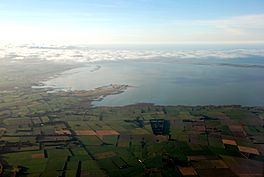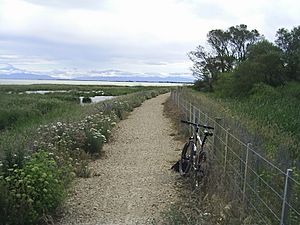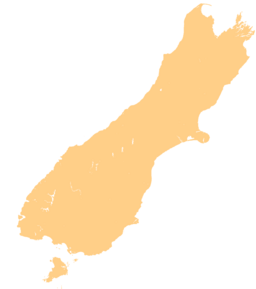Lake Ellesmere / Te Waihora facts for kids
Quick facts for kids Lake Ellesmere / Te Waihora |
|
|---|---|

Aerial view of Lake Ellesmere / Te Waihora
|
|
| Location | Selwyn District and Christchurch City, Canterbury region, South Island |
| Coordinates | 43°48′S 172°25′E / 43.800°S 172.417°E |
| Type | Brackish lagoon |
| Primary inflows | Selwyn River / Waikirikiri |
| Basin countries | New Zealand |
| Max. length | 30.5 km (19.0 mi) |
| Max. width | 14.5 km (9.0 mi) |
| Surface area | 197.81 km2 (76.37 sq mi) |
| Max. depth | 2.1 m (6 ft 11 in) |
| Surface elevation | 2 m (6 ft 7 in) |
Lake Ellesmere / Te Waihora is a large lake in the Canterbury area of New Zealand's South Island. It's not a typical lake, but a wide, shallow lagoon. A lagoon is a shallow body of water separated from the sea by a sandbar or barrier. This one is separated from the Pacific Ocean by a long, sandy strip of land called Kaitorete Spit.
The lake is partly in Selwyn District and partly in Christchurch. For the Māori people, the lake is very important. Its traditional Māori name, Te Waihora, means spreading waters. Since 1938, it has officially had both the English and Māori names.
Contents
What is Lake Ellesmere / Te Waihora like?
Lake Ellesmere / Te Waihora is a brackish lagoon. This means its water is a mix of fresh and salty water. It covers about 198 square kilometers (76 square miles). This makes it New Zealand's fifth largest lake by area.
Lagoons like this one are part of a chain of important natural areas. They form a "habitat corridor" along the east coast of the South Island. This corridor includes other lagoons like Wairau Lagoon and Lake Grassmere in Marlborough. It also includes Coopers Lagoon, Washdyke, Wainono Lagoon, and Waituna Lagoon.
Where does the lake's water come from?
Most of the water in Lake Ellesmere / Te Waihora comes from underground water. This groundwater flows through the gravelly land of the Canterbury Plains. The underground water is refilled by rainfall on the plains. It also gets water from underground leaks from the Rakaia and Waimakariri Rivers.
Sometimes, especially in winter, the lake also gets water from surface streams. These streams flow from the foothills near the Rakaia Gorge to Darfield. The way people use the land around the lake has changed a lot. This has caused big changes to the lake's environment. Lagoons like this are very sensitive to how humans use the land nearby. This includes changes to water flow and the amount of dirt and chemicals that enter the lake.
Animals and nature
What animals live near the lake?
While rare, large ocean animals sometimes visit the coast near the lake. These include southern right whales and humpback whales. They can sometimes be seen playing or resting near places like Birdling's Flat.
The endangered Hector's dolphins are found here in good numbers. These small dolphins are special to New Zealand. You might also spot Southern elephant seals or New Zealand fur seals spending time in the lake. Even large Basking sharks have occasionally entered the lake!
How did the lake form?
Lake Ellesmere / Te Waihora is less than 5,000 years old. But it has changed a lot in that short time! In the past, it was twice as deep and twice as big. It has gone through different stages to become the brackish lagoon we see today.
First, the area was part of the Canterbury plains. Then, it was flooded and became a bay. After that, it turned into an estuary (where a river meets the sea). Finally, it became the lake or lagoon it is now.
The main reason Lake Ellesmere / Te Waihora formed was the creation of the Kaitorete Barrier. This barrier is often called a "spit," but that's not quite right. A spit is usually widest at one end and gets narrower. The Kaitorete Barrier is actually narrower at its southern end and widest at its northern end. It's also connected to the land at both ends. So, it's technically a barrier beach.
The Kaitorete Barrier started forming about 20,000 years ago. At that time, glaciers in Canterbury melted, sending huge amounts of sand, gravel, and silt to the coast. The sea level was much lower then, about 130 meters (426 feet) lower than today. The coast was up to 50 kilometers (31 miles) east of where it is now. This meant the Canterbury plains were twice as wide!
Then, the sea level rose quickly. This flooded what is now the continental shelf, moving the coastline westward. About 10,000 years ago, the Canterbury coast reached the area where Lake Ellesmere / Te Waihora is now. The coast was made of loose sand and gravel from big rivers like the Rakaia and Waimakariri. Powerful waves from the south hit the Canterbury Bight. This strong wave action and loose land caused fast coastal erosion. It also moved a lot of sand and gravel northward along the shore.
All these events led to the lake's formation. The rising sea level flooded the plains. Fast erosion of the southern coast provided a huge supply of sand and gravel. Strong waves moved these materials north towards Banks Peninsula. This built the Kaitorete Barrier that now surrounds the lake. If left alone, Lake Ellesmere / Te Waihora might become a saltwater estuary again in a few hundred years.
Cultural importance
Lake Ellesmere / Te Waihora has always been a special mahinga kai for Māori. A mahinga kai is a place important for gathering food and other natural resources. It is still very important to many Māori living in the area today.
In 1998, the ownership of the lake bed was given back to Te Rūnanga O Ngāi Tahu. This was part of the Ngāi Tahu Claims Settlement. Now, they can manage this important place and show their rangatiratanga (ownership).
The lake's traditional name was Te Kete Ika o Rākaihautū. This means "the fish basket of Rākaihautū". The lake used to be full of food like tuna (eels), pātiki (flounder), and aua (mullet). It was also famous for being a mahinga manu wai māori, a place to catch waterfowl.
Sadly, much of the lake's richness as a mahinga kai has been lost. This is because land around it has been turned into farmland. The lake is often drained to keep the farmland dry. In the past, before European settlers arrived, the lake's water level was carefully kept at the best level for birds. This provided kai (food) for many people. The lake was only drained when the water got too high. People would drag kōrari (flax stalks) across the sand to open a channel to the sea. This careful draining happened for hundreds of years. It helped keep Lake Ellesmere / Te Waihora full of food.
In 2007, Ngai Tahu and the National Institute of Water and Atmospheric Research (NIWA) studied the lake's cultural health. They found that the lake, especially its edges, still holds important mahinga kai values. This is true even with issues like water quality and changes to native plants.
The study also identified unique themes and health signs for the lake. Changes were caused by:
- More farming and land use.
- Draining and changing wetlands.
- Lower water quality.
- Less access to mahinga kai.
- Less water flowing into the lake.
Big changes over time included:
- Loss of mahinga kai habitats.
- Loss of matauranga Ngai Tahu (local Māori knowledge).
- Commercial fishing taking over.
- Less use of the lake by the community.
- Damage to the mauri (life force) and mana of the lake.
For the Māori people, good things for the future include:
- Bringing back native habitats.
- Higher and changing lake levels.
- More native birds.
- Less dirt and erosion.
- Better management.
- More Ngai Tahu and community use.
- Bringing back mahinga kai activities.
- Restoring Te Kete Ika o Rakaihautu/The Fish Basket of Rakaihautu.
Fun activities at the lake

Lake Ellesmere / Te Waihora is also a very important place for fun activities. It's known across the country for waterfowl hunting. It's also important for fishing and cycling on the rail trail in the region.
Many activities happen here, both on the water and on land. These include fishing, hunting for waterfowl, bird-watching, picnicking, and camping. You can also go cycling, trail biking, or enjoy scenic drives. Water sports like kayaking and water-skiing are popular too.
Many of these activities need a healthy natural environment. This is especially true for fish and wildlife habitats. Since 1996, fewer people have been trout fishing and doing other activities. This shows the lake's health is affecting recreation.
The lake's health and future
In 2010, a report said Lake Ellesmere / Te Waihora was the second most polluted lake in New Zealand. This was based on its nutrient content and how much algae grew in it. Algae blooms (when algae grows very fast) happen often in summer. In 2009, toxic algae bloomed in the lake.
Also, most streams flowing into the lake have too much bacteria. This means they are not safe for swimming. Some streams even have levels of bacteria too high for animals to drink. Test results for E. coli bacteria are also poor. Many sites around the lake do not meet national safety standards for water quality. No sites were safe for gathering shellfish or for drinking.
However, there's some discussion about how "polluted" the lake truly is. Even though it has high nutrients and algae, it doesn't always act like a very polluted lake. For example, it doesn't often run out of oxygen, or have ugly toxic algae blooms, or cause fish to die. Other lakes with similar nutrient levels do have these problems. Plus, Lake Ellesmere / Te Waihora still supports many fish and bird communities.
Recently, people have realized that taking too much water from underground, combined with climate changes, is lowering groundwater levels. This then affects the streams that feed the lake. We can't stop the lake from depending on groundwater. But we hope that by managing how much groundwater is taken out, especially when water levels are low, the lake will stay healthy.
Since Lake Ellesmere / Te Waihora is a lowland lake, it gets water not just from nearby areas but from the wider plains. The quality of the streams flowing into the lake shows how much farming happens around them. Many sites have high levels of nutrients and bacteria. This means the problem is big and needs wide-ranging solutions.
Because the lake relies on groundwater, the local authority, Environment Canterbury, is working to restore lowland streams. Protecting the areas along the lake's edge and its streams will help a lot. It will reduce pollution like dirt and phosphorus. But to truly improve the lake, we need to manage nutrients and water use across the entire area that feeds the lake.
See also
 In Spanish: Lago Ellesmere/Te Waihora para niños
In Spanish: Lago Ellesmere/Te Waihora para niños




